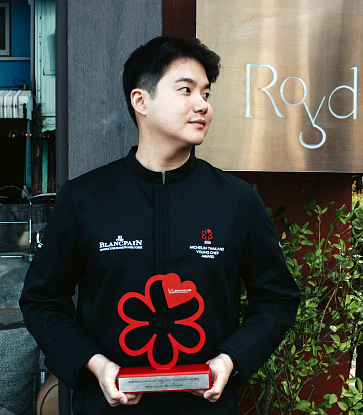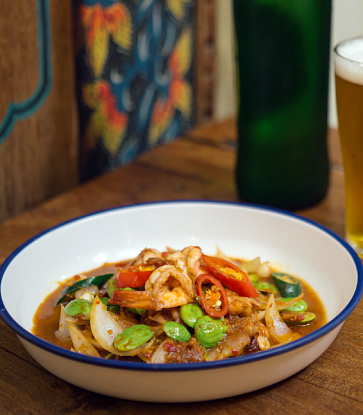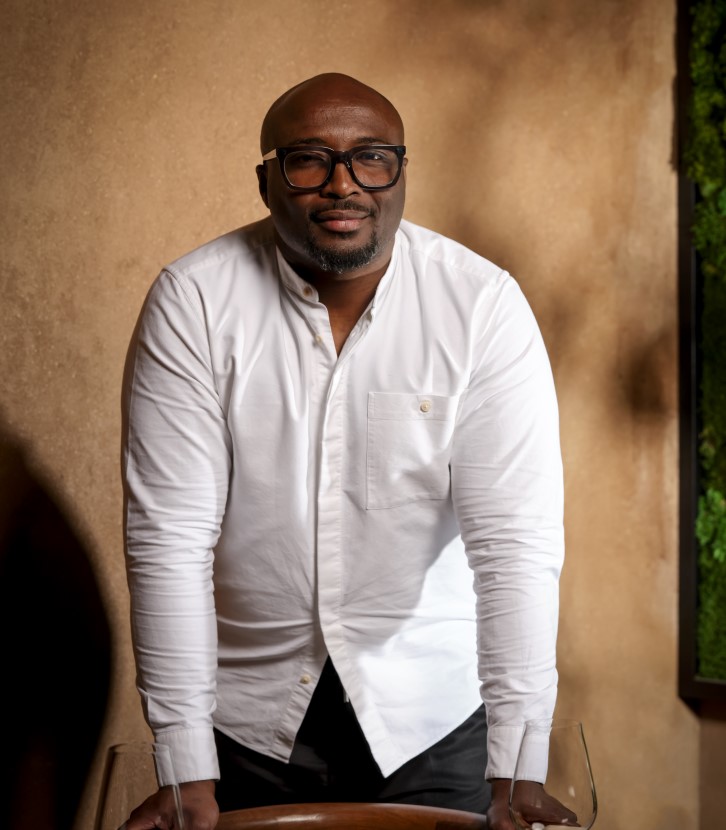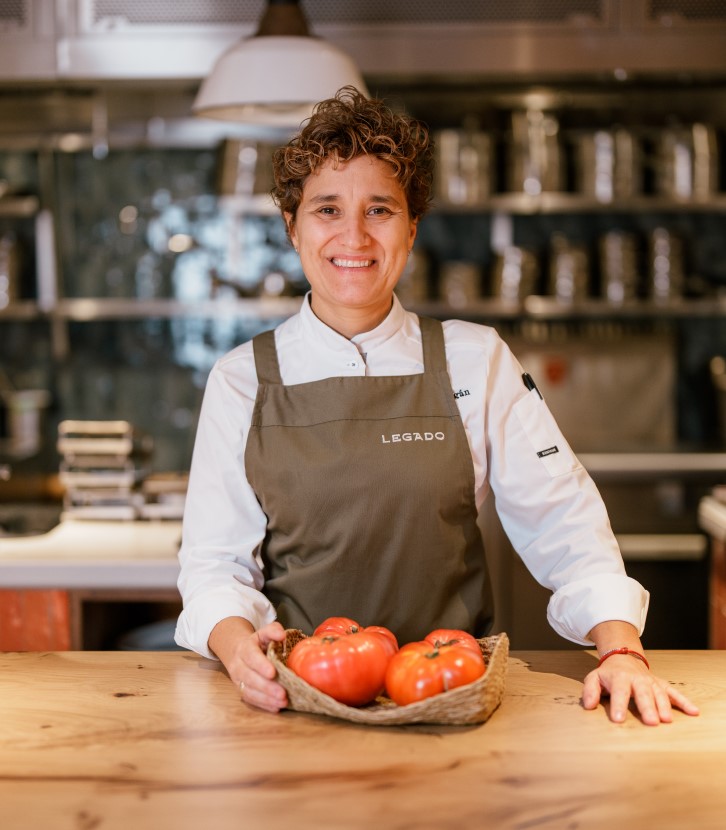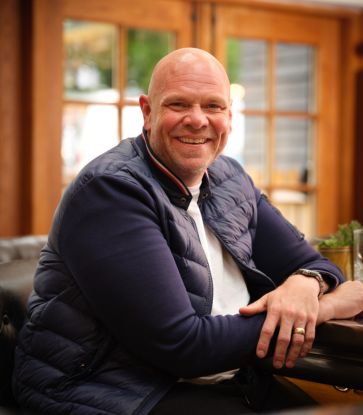It's too easy to be cynical about new food trends and eye-catching photos of dishes that look more like a piece of art than an appetiser. Following the recent hype around their signature dish, we visited Canvas (one MICHELIN Star, MICHELIN Guide Thailand 2022) with an appetite for intrigue, curious to learn about the plat de jour that's in the midst of a love affair with the Instagram generation.
Bounty is the kaleidoscopic showpiece and only plant-based dish on the eye-popping 22-course tasting menu. Before meeting Chef Riley Sanders, we watched the kitchen team preparing for the evening's sitting.
The executive chef demonstrated his artistic prowess by painting the ingredients onto a plate to recreate the famous dish. He began with eight pre-prepared sauces that resemble the bright, primary colours of an oil paint kit: using purees like sweetcorn, mango and turmeric, and beetroot.
With a palette knife, he dropped a blob of each colour around the plate and blended the colours using lines and smears. The American then demonstrated his encyclopaedic knowledge of Thai ingredients while tweezing them precisely into the contemporary design – some you've heard of, and many others with names that strain the ears.
Next, to meld the masterpiece into one design, the artist sprinkled a rainbow collection of coloured powders, including green pandan, red cabbage, purple beetroot, dried shitake mushroom, orange mango, butterfly pea, and red tomato. Finally, he added a liberal application of dried chilli sauce with garlic and shallots, and a citrus juice vinaigrette. This would infuse a spicy and sour consistency throughout the dish.
“That…” he announced, “…is Bounty.”
Every dish on the 22-course journey is matched by a painting that's displayed in the menu, like a gallery brochure, but with the artist’s blurb and description missing. We had to ask Chef Sanders – Which came first: the artist's rendition or the recipe? The composition or the veg? The chicken or the jpeg?
“We want to show off the huge variety of vegetables that are available here, not limited to one region.”
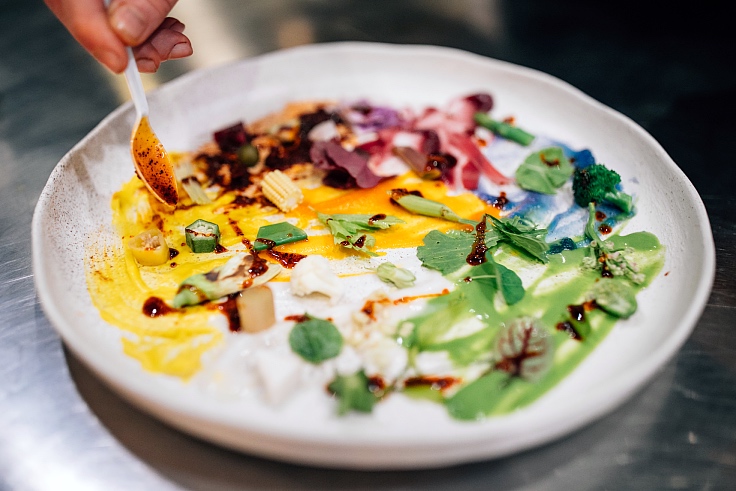
Art imitates his life's work
While many of us struggled to learn to make sourdough during the COVID lockdown, Sanders took up painting. It quickly became his hobby, and when the restaurant opened up again, he started to paint his dishes. This was a new way to communicate the often complex concoctions to customers."If you're explaining food that's innovative, you can choose a few words to do it, and name a few ingredients, but it doesn't tell you very much," he said. "I want to tell people more about it, for people to connect with it, and for them to be excited about it."
The paintings provided a new way to do this: the perfect representation of Canvas as a brand, and a different way of looking at food.
Chef Sanders originally trained as a chef in Austin, Texas, before working on a super yacht based out of Miami for three years. In 2016, he jumped at the opportunity to open his own restaurant in Bangkok where he could continue developing his knowledge about Thai ingredients by exploring the popular and the obscure at wonderful markets.
Bounty is inspired by the colours, diversity, flavours, varieties, and seasonality of these markets. Our serving contained more than 50 vegetables from all over Thailand. Each one was prepared differently, whether grilled, roasted, pickled, sautéed, fermented, steamed, or raw. With the sauces, herbs, and spices added, the Texan chef believed the sum total to be somewhere north of 80 ingredients.
"We want to show off the huge variety of vegetables that are available here, not limited to one region," Sanders said. The very day that something new arrives in the market, they can serve it that night. This means that the dish is constantly evolving.
Every evening, a new sitting of customers will receive something slightly different. There won't be drastic differences, but as the seasons evolve, this dish reflects those changes.

A concerto of three seasons
While Thailand’s three seasons are distinct, they also contain micro seasons, Sanders said. In June, we're at the start of the rainy season. Typically, the rains start up north, in Isan, and also in the south. So we see wild mushrooms such as Thai porcini, termite, and duck egg mushrooms. We're also starting to see bamboo shoots. As we continue through to July, we'll start to find things like mulberries, persimmons, and dates.“Right now, we're at the peak of the fruit season,” he said. “But as the rains continue and we approach the cold season, fruits like durian, mangosteen, and rambutan will begin to disappear.”
The cold season, while still stiflingly hot for many tourists, is relatively cool in the northern, mountainous regions – maybe 10-15 degrees at night – so they can grow strawberries and marian plums during that short period of the year.
“Some people will scoop it up. Others like to take it slow. They go from green to blue, to pink, to purple, to red.”

Science behind the colourful dish
Chef Sanders organises his notes and his menu in a monthly journal. He makes lists of what comes into season to plan future dishes for the menu. He speaks a little Thai and spends a couple of hours a day thinking about ingredients, researching, and visiting markets.Talaat Thai is an enormous wholesale market north of the city. Much of the country's produce ends up here. Or Tor Kor market, next to Chatuchak, is great for fruits, seafood, and organics. Khlong Toei market, in the centre, features a superbly wild variety, particularly from the Isan region. Riley muses that he sometimes finds an item in the market that he loves... and then never sees it again.
When the American chef finds a rare ingredient online, he takes a picture of it, figures out its Thai name if it has any use in traditional Thai cooking. More often than not, the suppliers can't find it. But it's particularly rewarding when they do. And his suppliers are on board with the mission to source the bizarre, the unique, and the diverse. So, they often come up with little surprises too.
Bounty, the most colourful dish on his, or possibly any, menu, is a signature because it references more than the ingredients found in his kitchen. It represents the medley of the markets – bright colours that translate into bright, fresh flavours. In a dimly lit dining room, the colours dance on the plate and out through the dark.

Secrets in the design
The design of a new dish can often feel like painting by numbers, Sanders explained. “You have to include some sort of protein, perhaps a starch, a herb, and a sauce.”By including Bounty on the menu, the chef cum artist feels he has removed these constraints. The other dishes don't necessarily have to include a vegetable that wouldn't make sense in a lamb, wagyu, or fish dish. He feels this creates a focus without distractions that's more pure.
The kitchen lead at Canvas takes inspiration from a dipping sauce that he believes is quintessentially Thai – nam prik. Bounty, he stated, “blurs the lines between the definitions of a salad and a nam prik.” It's a little bit spicy, salty, sour, and sweet. It has a lot of those flavours you associate with Thai food, but there's no single main component.
One cook on the Canvas team is solely responsible for preparing Bounty. They spend three to four hours a day getting the vegetables together.
We asked the chef if he ever gets frustrated by the way his customers eat a dish. He smiled. "People love to take pictures. It's fun. But I'd rather they didn't wait so long to start eating it."
What about the technique to eat this particular dish? Should they eat each vegetable as singular mouthfuls or shovel across the plate to combine all the different flavours? "You can’t really go wrong," he explained. “Some people will scoop it up. Others like to take it slow. They go from green to blue, to pink, to purple, to red.”
In other words, Bounty offers diners their own immersive interaction with the art and the canvas.
In reality, the Canvas menu isn't designed for the average street foodie. Its prices are better suited to the wallets of the haves and have yachts. But Sanders' devotion to his research and art produces results worthy of the top table, with deliciously satisfying flavours for fine diners and lens-pleasing colours for Instagrammers.
Hero image © Akkapat Inthuprapa / MICHELIN Guide Thailand




